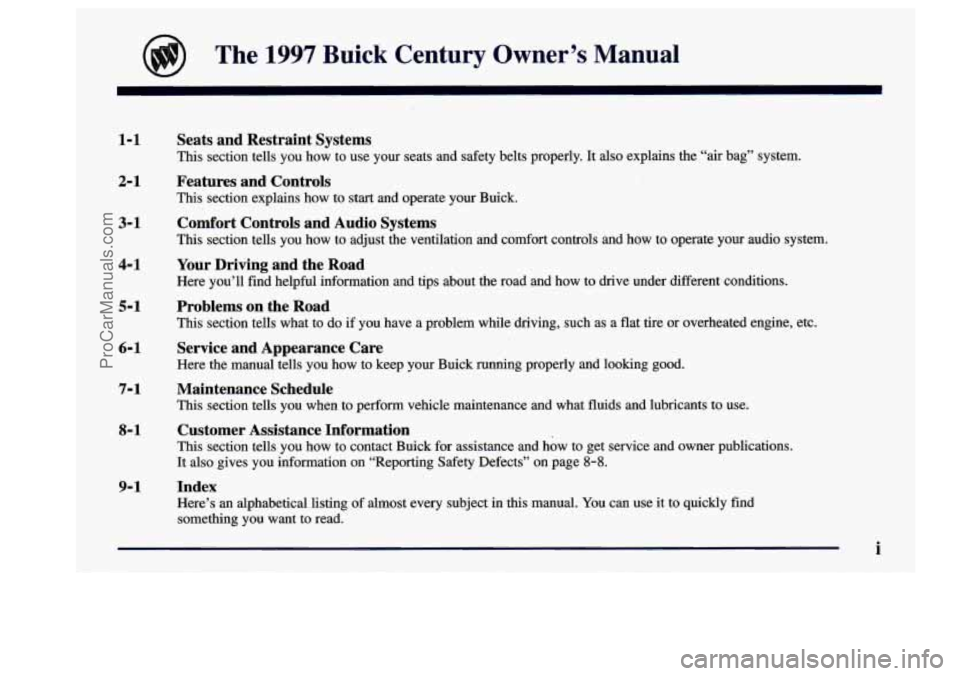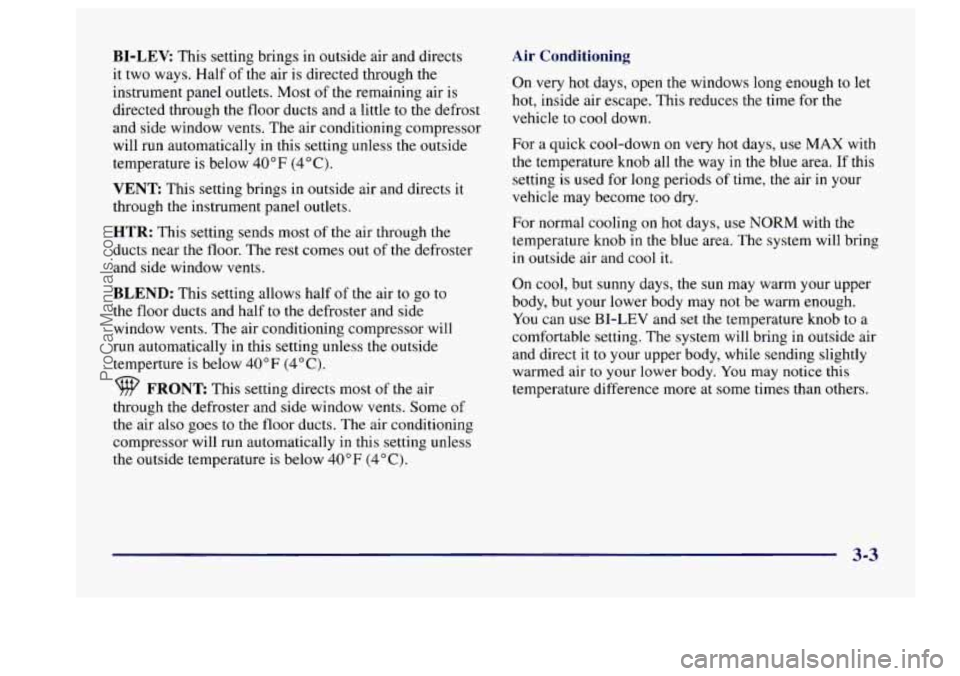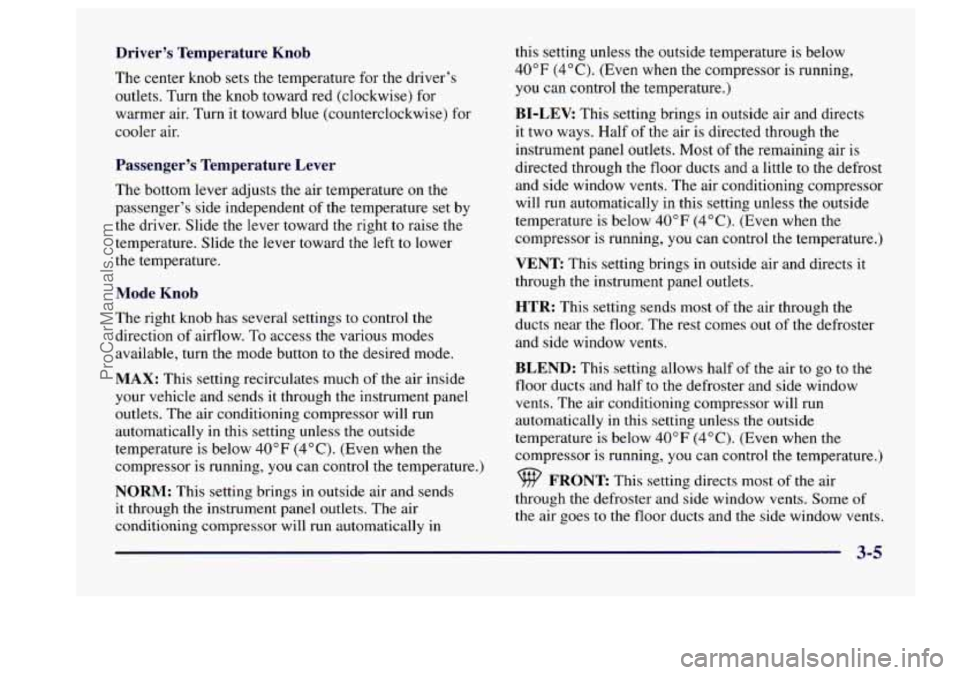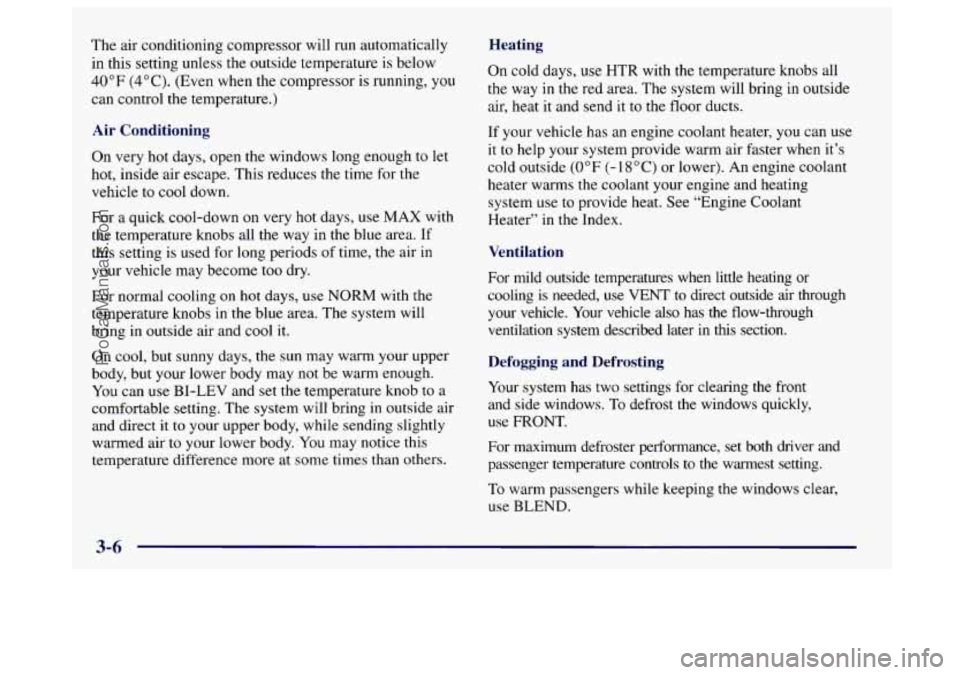1997 BUICK CENTURY air condition
[x] Cancel search: air conditionPage 3 of 406

The 1997 Buick Century Owner’s Manual
1-1
2- 1
3-1
4-1
5-1
6-1
Seats and Restraint Systems
This section tells you how to use your seats and safety belts\
properly. It also explains the “air bag” system.
Features and Controls
This section explains how to start and operate your Buick.
Comfort Controls and Audio Systems
This section tells you how to adjust the ventilation and comfo\
rt controls and how to operate your audio system.
Your Driving and the Road
Here you’ll find helpful information and tips about the road\
and how to drive under different conditions.
Problems on the Road
This section tells what to do if you have a problem while driving,\
such as a flat tire or overheated engine, etc.
Service and Appearance Care
Here the manual tells you how to keep your Buick running prop\
erly and looking good.
7-1 Maintenance Schedule
This section tells you when to perform vehicle maintenance and what \
fluids and lubricants to use.
8- 1
9-1
Customer Assistance Information
This section tells you how to contact Buick for assistance and how \
to get service and owner publications.
It also gives you information on “Reporting Safety Defects”\
on page 8-8.
Index
Here’s an alphabetical listing of almost every subject in this manual. You can use it to quickly find
something you want to read.
i
ProCarManuals.com
Page 133 of 406

The air bag readiness light should flash for a few
seconds when you turn the ignition key to RUN.
If the
light doesn’t come
on then, have it fixed so it will be
ready to warn you if there is
a problem.
Charging System Light
4
The charging system light
will come on briefly when
you turn
on the ignition, as
a check to show
you it’s
working. Then it should
go out.
If it stays on, or comes on while you are driving, you
may have a problem with the charging system. It could
indicate that you have a loose drive belt or another
electrical problem. Have it checked right away. Driving
while this light is on could drain your battery.
If you must drive a short distance with the light on, be
certain
to turn off all your accessories, such as the radio
and air conditioner.
Brake System Warning Light
Your Buick’s hydraulic brake system is divided into two
parts. If
one part isn’t working, the other part can still
work and stop you. For good braking, though, you need
both parts working well.
If the warning light comes on, there could be
a brake
problem. Have your brake system inspected right away.
BRAKE
This light should come
on briefly when you turn
the ignition key
to RUN.
If it doesn’t come
on then,
have it fixed
so it will be
ready to warn
you if there’s
a problem.
If the light comes
on while you are driving, pull off the
road and stop carefully. You may notice that the pedal is
harder to push. Or, the pedal may go closer to the floor.
It may take longer to stop. If the light is still
on, or if the
anti-lock brake system warning light is flashing, have
the vehicle towed for service. (See “Anti-Lock Brake
System Warning Light” and “Towing Your Vehicle” in
the Index.)
2-57
ProCarManuals.com
Page 138 of 406

Malfunction Indicator Lamp
(Service Engine Soon Light)
Your Buick is equipped
with a computer which
monitors operation
of the
fuel, ignition and emission
SERVICE ENGINE control systems.
SOON
This system is called OBD I1 (On-Board
Diagnostics-Second Generation) and
is intended to
assure that emissions are at acceptable levels for the life
of the vehicle, helping
to produce a cleaner
environment. (In Canada,
OBD I1 is replaced by
Enhanced Diagnostics.) The SERVICE ENGINE
SOON
light comes on and a chime will sound to indicate that
there
is a problem and service is required. Malfunctions
often will be indicated by the system before any
problem is apparent. This may prevent more serious
damage to your vehicle.
This system is also designed to
assist your service technician in correctly diagnosing
any malfunction.
NOTICE:
If you keep driving your vehicle with this light
on, after a while, your emission controls may not
work as well, your fuel economy may not be as
good and your engine may not run as smoothly.
This could lead to costly repairs that may not be
covered by your warranty.
This light should come on, as a check to show you it is
working, when the ignition is on and the engine is
not
running. If the light doesn’t come on, have it repaired.
This light will also come on during a malfunction in one
of two ways:
Light Flashing -- A misfire condition has been
detected.
A misfire increases vehicle emissions and
may damage the emission control system on your
vehicle. Dealer or qualified service center diagnosis
and service is required.
Light On Steady -- An emission control system
malfunction has been detected on your vehicle.
Dealer or qualified service center diagnosis and
service may be required.
2-62
ProCarManuals.com
Page 146 of 406

Comfort Controls
Manual Single Zone Climate Control
- .
0 IIl
COMFORT CONTROL II
With this system, you can control the heating, cooling
and ventilation in your vehicle. The system works best
if
you keep your windows closed while using it.
Fan Knob
The left knob selects the amount of air you want. To turn
the fan
off, turn the knob to OFF.
If the airflow seems very low when
the fm knob is
turned
to the highest setting, regardless of the mode
setting, your passenger compartment air filter may
need
to be replaced. See "Maintenance Schedule" in
the Index.
Temperature Knob
The center knob changes the temperature of the air
coming through the system. Turn this knob toward
red (clockwise) for warmer air. Turn it toward blue
(counterclockwise) for cooler air.
Mode Knob
The right knob has several settings to control the
direction of airflow:
MAX: This setting recirculates much of the air inside
your vehicle and sends it through the instrument panel
outlets. The air conditioning compressor will run
automatically in this setting unless the outside
temperature is below 40°F
(4°C). (Even when the
compressor is running, you can control the temperature.)
NORM: This setting brings in outside air and sends
it through the instrument panel outlets. The air
conditioning compressor will run automatically in
this setting unless the outside temperature is below
40°F (4°C). (Even when the compressor is running,
you can control the temperature.)
3-2
ProCarManuals.com
Page 147 of 406

BI-LEV: This setting brings in outside air and directs
it two ways. Half
of the air is directed through the
instrument panel outlets. Most of the remaining air is
directed through the floor ducts and a little
to the defrost
and side window vents. The air conditioning compressor
will run automatically in this setting unless the outside
temperature is below 40°F (4°C).
VENT This setting brings in outside air and directs it
through the instrument panel outlets.
HTR: This setting sends most of the air through the
ducts near
the floor. The rest comes out of the defroster
and side window vents.
BLEND: This setting allows half of the air to go to
the floor ducts and half to the defroster and side
window vents. The air conditioning compressor will
run automatically in this setting unless the outside
temperture is below 40°F (4°C).
9 FRONT This setting directs most of the air
through the defroster and side window vents. Some
of
the air also goes to the floor ducts. The air conditioning
compressor will run automatically in this setting unless
the outside temperature is below
40°F (4°C).
Air Conditioning
On very hot days, open the windows long enough to let
hot, inside air escape. This reduces the time for the
vehicle to cool down.
For a quick cool-down
on very hot days, use MAX with
the temperature knob all the way
in the blue area. If this
setting is used for long periods of time,
the air in your
vehicle may become too dry.
For normal cooling on hot days,
use NORM with the
temperature knob in the blue area. The system will bring
in outside air and cool it.
On cool, but sunny days, the sun may warm your upper
body, but your lower body may not be warm enough.
You can use BI-LEV and set the temperature knob to a
comfortable setting. The system will bring in outside air
and direct
it to your upper body, while sending slightly
warmed air
to your lower body. You may notice this
temperature difference more at some times than others.
3-3
ProCarManuals.com
Page 149 of 406

Driver’s Temperature Knob
The center knob sets the temperature for the driver’s
outlets. Turn the knob toward red (clockwise) for
warmer air. Turn it toward blue (counterclockwise) for
cooler air.
Passenger’s Temperature Lever
The bottom lever adjusts the air temperature on the
passenger’s side independent of the temperature set by
the driver. Slide
the lever toward the right to raise the
temperature. Slide the lever toward
the left to lower
the temperature.
Mode Knob
The right knob has several settings to control the
direction of airflow. To access the various modes
available, turn the mode button to the desired mode.
MAX: This setting recirculates much of the air inside
your vehicle and sends it through the instrument panel
outlets. The air conditioning compressor will run
automatically in this setting unless the outside
temperature is below 40°F (4°C). (Even when
the
compressor is running, you can control the temperature.)
NORM: This setting brings in outside air and sends
it through the instrument panel outlets. The air
conditioning compressor will run automatically
in
this setting unless the outside temperature is below
40°F
(4°C). (Even when the compressor is running,
you can control the temperature.)
BI-LEV This setting brings in outside air and directs
it two ways. Half
of the air is directed through the
instrument panel outlets. Most of the remaining air
is
directed through the floor ducts and a little to the defrost
and side window vents. The air conditioning compressor
will
run automatically in this setting unless the outside
temperature is below 40°F (4°C). (Even when the
compressor
is running, you can control the temperature.)
VENT This setting brings in outside air and directs it
through the instrument panel outlets.
HTR: This setting sends most of the air through the
ducts near
the floor. The rest comes out of the defroster
and side window vents.
BLEND: This setting allows half of the air to go to the
floor ducts and half to the defroster and side window
vents. The air conditioning compressor will run
automatically in this setting unless the outside
temperature is below 40°F (4°C). (Even when the
compressor is running, you can control
the temperature.)
FRONT This setting directs most of the air
through the defroster and side window vents. Some
of
the air goes to the floor ducts and the side window vents.
3-5
ProCarManuals.com
Page 150 of 406

The air conditioning compressor will run automatically
in this setting unless the outside temperature is below
40°F
(4°C). (Even when the compressor is running, you
can control the temperature.)
Air Conditioning
On very hot days, open the windows long enough to let
hot, inside air escape. This reduces the time for the
vehicle to cool down.
For a quick cool-down on very hot days, use MAX with
the temperature knobs all the way in the blue area. If
this setting is used for long periods of time, the air
in
your vehicle may become too dry.
For normal cooling on
hot days, use NORM with the
temperature knobs in the blue area. The system will
bring in outside air and cool it.
On cool, but sunny days, the
sun may warm your upper
body, but your lower body may not be warm enough.
You can
use BI-LEV and set the temperature knob to a
comfortable setting. The system will bring in outside air
and direct it to your upper body, while sending slightly
warmed air to your lower body.
You may notice this
temperature difference more at some times than others.
Heating
On cold days, use HTR with the temperature knobs all
the way
in the red area. The system will bring in outside
air, heat it and send
it to the floor ducts.
If your vehicle has an engine coolant heater, you can
use
it to help your system provide warm air faster when it’s
cold outside (0°F
(- 1 SOC) or lower). An engine coolant
heater warms the coolant your engine and heating
system use to provide heat. See “Engine Coolant
Heater” in
the Index.
Ventilation
For mild outside temperatures when little heating or
cooling is needed, use
VENT to direct outside air through
your vehicle. Your vehicle also has the flow-through
ventilation system described later in this section.
Defogging and Defrosting
Your system has two settings for clearing the front
and side windows. To defrost
the windows quickly,
use
FRONT.
For maximum defroster performance, set both driver and
passenger temperature controls to the warmest setting.
To warm passengers while keeping the windows clear,
use
BLEND.
ProCarManuals.com
Page 151 of 406

Dual Automatic ComforTemp Climate Control (If Equipped)
With this system, you set a temperature. You can then
either let the system automatically control airflow
direction and force it to maintain the temperature, or you
can manually adjust
it. The system works best if you
keep your windows closed while using it.
Automatic Control
For the most efficient operation, you should set the
system temperature and press
AUTO. The system will
select the best fan speed and airflow settings to keep you
comfortable. The air conditioning compressor will run if
the outside temperature is above
40°F (4°C). You may
notice a delay of two to three minutes before the fan
comes on at start up in cool weather.
Driver’s Temperature Control
The TEMP switch sets the temperature for the entire
system when the light on the
DUAL button isn’t lit. If
the light is lit, this control sets the temperature for the
driver only. Press the up arrow to raise the temperature
and press the down arrow to lower the temperature. The
display will show your selection for a few seconds, then
the outside temperature will show.
If you push the
AUTO button,
the system will control the fan speed
and airflow.
3-7
ProCarManuals.com